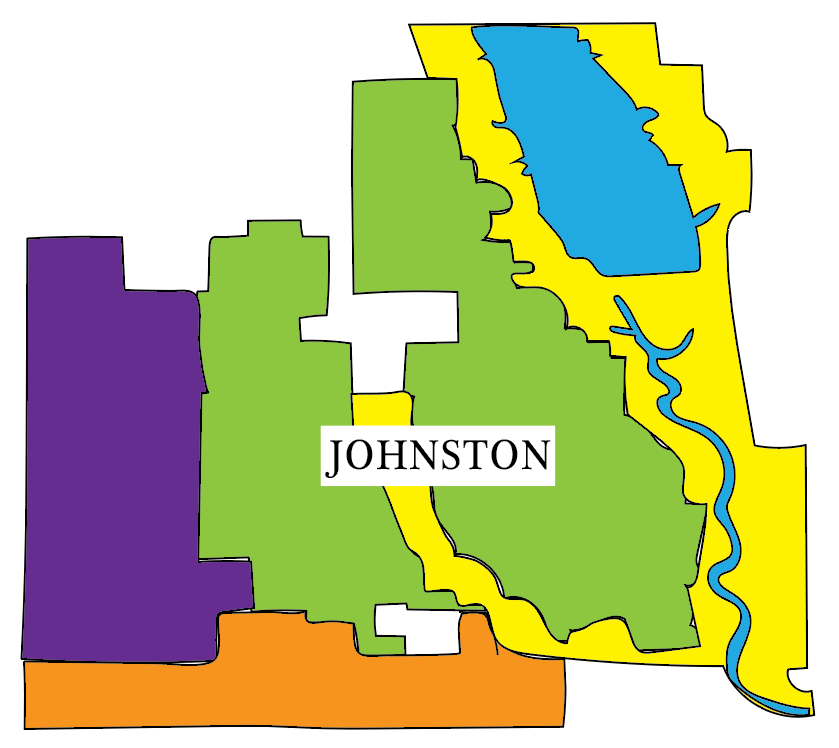Johnston May Face Metropolitan Consumption.
Landlocked by several different cities, Johnston could possibly face future limitations in expanding its infrastructure to adapt to a new age.
An outline of the city of Johnston.
January 22, 2020
Dominated by agricultural industries, neighborhoods sprawling on every corner, schools, roundabouts, Camp Dodge, and Saylorville Lake, Johnston, has never been better. With small patches of new housing, and businesses popping up around the city, Johnston is socially, and economically thriving heading into the 2020’s. However, time still goes on, and with the future always in question, one may wonder, what will Johnston look like in the 30’s, 40’s or even 50’s? In mid-20th century, Pioneer began to expand its corn growing experiments into Johnston, and eventually turned into Corteva, bringing 2,000 employees into the community with it.
However, with the massive overtake of Corteva, John Deere Financial, and Camp Dodge being built in WWI, space has grown light to expand. Confined by the borders of Urbandale to the South, Grimes to the East, and Saylorville Lake and the forests and recreational areas covering most of the North and West, Johnston seems to be stuck within the confines of said areas.
Covering most of the border of Johnston, Saylorville Lake and the wooded greenery packaged with it, halts any chance of expansion in the Northeastern direction. Providing campgrounds, hunting, fishing and hiking, the area appeals to most residents near Johnston, Grimes, and the Polk City area. Any speak of invading said space is sure to spark unwanted conflict between many people who enjoy said activities, and is best left untouched for the enjoyment of residents near Saylorville Lake, and the betterment of the environment. Any land near Camp Dodge is untouchable for safety reasons, and many open lots have been set aside for neighborhoods to soon be in development.
There are many major construction projects that Johnston has taken on in the last decade. “There have been some different high profile road reconstruction projects that you might have noticed,” City Planner Clayton Ender said. “NW 70th Avenue got reconstructed, NW 100th Street, NW 62nd Avenue, and we’ve been completely reconstructing all the roadways east of Merle Hay.”
The importance of greenery and nature is a priority to the city of Johnston. “We’ve also been focusing on storm water a lot more in the last decade trying to protect our streams from pollution and erosion,” Ender said. “Really we’ve been growing an emphasis on making sure our streams, lakes, rivers are clean.” Along with these actions taken, the city of Johnston had their first ribbon cutting for the first Canoe Kayak Launch of the greater Des Moines water trails this past year. They hope to have over 150 miles of water trails for people to use recreationally.
The city of Johnston is different in the sense of how nature is such a powerful and inclusive part of the city. “We have some very sensitive things we have to take care to protect. We have the beavercreek natural resource area and the flood plains around beavercreek which are very critical to our environment,” Ender said.
Johnston’s borders have expanded over the years, but the idea of annexation has had its impact on the cities borders these last few years. “Over the past two years, we have annexed just shy of 1700 acres,” Ender said. “Johnston now extends all the way up to NW Saylorville drive, we’re all the way North of Camp Dodge, we’ve annexed along Highway 141, west of highway 141 even.” Johnston is predicted to add another 20,000 persons with the developments they have planned north.
Johnston has also taken on an advancement of economic development projects in the new city hall at the corner of Merle Hay and NW 62nd Avenue. “We’re constructing a new City Hall right behind our existing building and when all is said and done over the next 5-10 years we’ll have more retail options, restaurants, a new park with a splash pad in the summer, ice rink in the winter, a trailhead for people to take off and enjoy our regional bike trail system, office building and more office space as well,” Ender said.
Opposite of a landlocked community such as Johnston, cities such as Ankeny and West Des Moines enjoy luxuries of free expansion, in which their borders are much larger. West Des Moines have at least 14 planned construction projects ranging from engineering to parks and recreational sites on their city website. Ankeny has amassed a whopping 46 construction developments on their website available to the public. Many of these developments include schools, neighborhoods, activities, facilities for businesses, government buildings, parks and many more. Ankeny includes 543 miles of road 369 cup-de-sacs, 6,238 street lights, and 72 traffic lights on city roadways.
After looking at these large cities, and seeing what makes them appeal and stand out from your average midwest expanding community, Johnston has a few special aspects that make it stand out as well. “All the cities in the Des Moines Metro are special and have something great going for them, but I think that one thing that really stands out for Johnston is our connection to nature,” Ender said. “Wildlife is abundant, I think it just gives people good views. People like to live near green areas. While it can certainly be a constraint to us as a city and we have to be careful how we build and plan our city it’s a great asset and we want to make sure we’re protecting that because that’s what our residents tell us, ‘I moved to Johnston because I wanted to be closer to nature,’ and we hear that quite a lot. You’re not going to get this feeling downtown Des Moines or in just your typical subdivision in Waukee. You might have a farm field at your backdoor but you don’t have a forest.”
There is no true life or death threat stacked up against these stats, and no true danger, but an interesting stat to think about, none the less. As cities that continue to expand and grow their land and economies attract more people, they may stand out as a brighter option compared to the small neighborhood towns that surround the bustling central city of Des Moines in the metro area. However, it opens up a new thought that when tasked with reading this, many may not have considered. Maybe Johnston isn’t supposed to be a hustle and bustle city like Des Moines, but a nature oriented, growing neighborhood. At its core, that’s what Johnston truly aspires to be, and in no means is it a bad thing.
With the ever expanding modern businesses trends, and entertainment giants, maybe the movie theaters and bowling alleys better fit cities like Ankeny, and Waukee. As shown by the map, there is no doubt that Johnston is surrounded by other cities, but perhaps it isn’t an issue. With the annexations in recent years up north, a new town square to be built, and an additional 20,000 residents predicted, it seems that Johnston is right where it needs to be. As time goes on with these next 30, 40, 50 years, it seems as if Johnston is growing perfectly within its own little bubble and should have no problem developing the economy and community of the city within whatever borders central Iowa could possibly throw its way.






Owen Smith • Mar 12, 2020 at 10:21 pm
Just to clarify—Johnston is bordered by Urbandale to the South, Saylorville Lake to the Northeast, Grimes to WEST, and the town of Saylorville to the EAST. I dispute the description of Johnston as ‘confined.’ There are swaths of land between NW 2nd Ave. in Saylorville and the Des Moines River that have yet to be developed, and plenty of land north of 100th St and west of Beaver Ave all the way up to Saylorville Drive that developers have not been shy about developing. While Johnston’s rate of development is certainly nothing compared to Waukee or Ankeny, and is less retail-focused, it is certainly not slow. The city is certainly not confined.
Neil • Feb 18, 2020 at 1:53 pm
Grimes is to the West